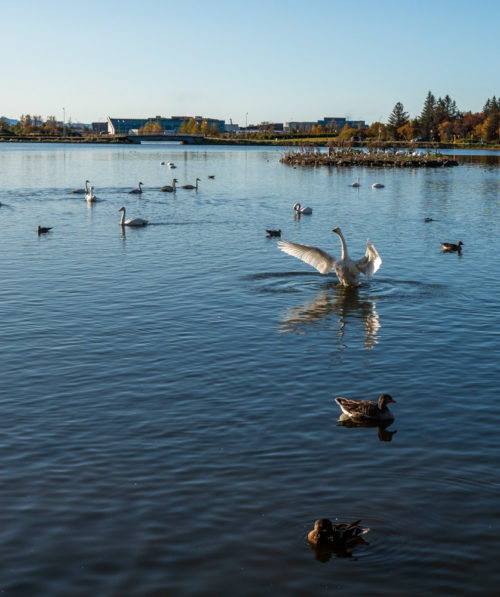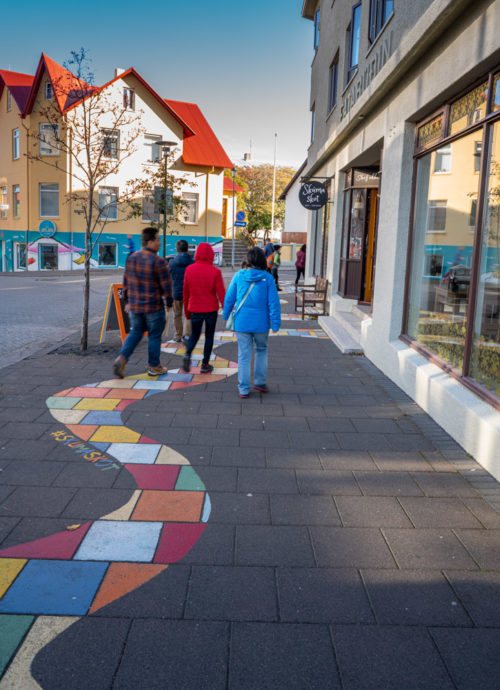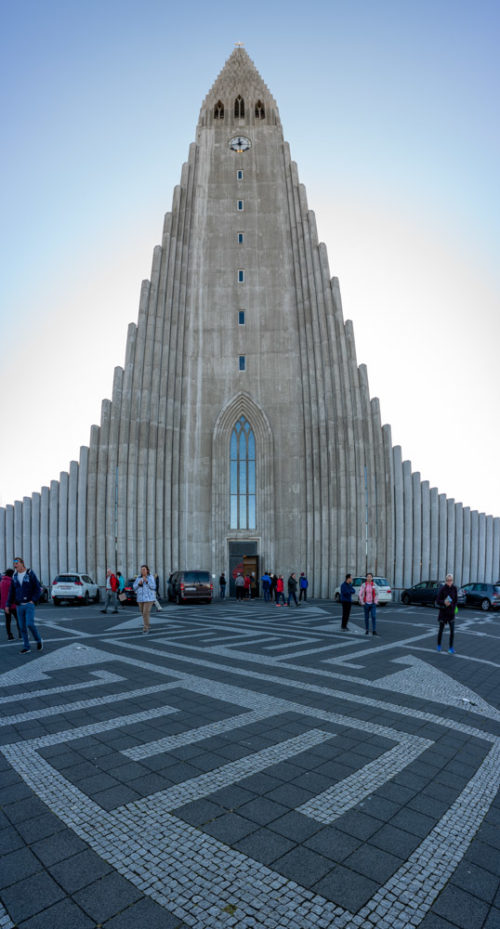
Recently I had taken few friends to Iceland for a Photo Tour. In the next few weeks, I will be blogging the details of that photo tour and here is the first part. We embarked on 28th September 2019 from Kempe gouda International airport in Bangalore to Amsterdam via Dubai in Emirates airways. From Amsterdam, we reached Reykjavik via Icelandair on 29 September afternoon. One of the first task after coming out of the airport was to hire an SUV for our 8-day journey around Iceland. We had booked Blue Car rental who came and picked us up from the airport and took us to their office to give us our vehicle for the trip. Our plan was to drive ourselves in one 4×4 and another 8-seater and drive all around Iceland using the ring road.

For Reykjavik stay we had booked Bus Hostel. It is situated close to the city centre. The rooms were bit small for comfort. One of the difficulties was that all rooms were upstairs and we had to lug all our luggage to the first floor that night and then pack it back again next day. The kitchen was average, but the toilets and bathrooms were clean. As soon as we freshened up, we had a quick dinner at a nearby Dominoes’ Pizza and rushed to see the Northern lights. You can check that blog on Northern Light here – Northern Lights

After exhilarating capture of northern lights, we were exhausted both from the excitement and from sleepless flight journey. We came back to the Bus hostel and crashed. Next morning after breakfast we wanted to explore few of the notable sightings at Reykjavik before heading towards Ring road.

First stop was Tjörnin. It is a small, prominent lake in central Reykjavík. Most visitors to the city pass along its shore, as it is situated in the city centre next to the Reykjavik City Hall and several museums. The lake is frequented by between 40 and 50 species of water birds, including the Arctic tern, the Eider, the Gadwall, the Greylag goose and other species of goose, the Mallard, several species of seagulls, and the scaup. We saw mainly Whooper swan are viewable within proximity.

Over the years, development of the city has centred around the lake. The postmodern City Hall, Ráðhúsið, stands in the northwest corner on the edge of the lake: it looks as if it is rising out of the lake. Other notable buildings in the area are those of the Supreme Court, Reykjavík Art Museum, the National Museum, the Living Art Museum, Reykjavík City Library, and the National Theatre, as well as the Parliament building, which houses the Parliament of Iceland, and the Dómkirkja cathedral are also close by.

The Monument to the Unknown Bureaucrat (1993) – Magnús Tómasson is located on the edge of the Tjörnin by the entrance of City Hall. This sculpture blends the figurative and abstract to comment on bureaucracy as a whole, and the workers within it. Originally it was located on a pedestal behind Hótel Borg, but in 2012 it was moved to this more fitting location, on the route most of the city’s council people and officials take to go to work. The sculpture depicts a man from the elbows down in a loose-fitting, crumpled suit with his left hand in his left pants pocket and his right hand holding a briefcase down by his right side. From the elbows up, the man is encased in a large unfinished slab of stone. The block of rock is a perfect metaphor for how everyday life crushes down on us, while at the same time depicting the narrative of the faceless official who is only a cog in the wheel, and never a person to most of us.

Our next destination was the Hallgrímskirkja church. On the way, we saw this sculpture of Water Carrier (1937) by Ásmundur Sveinsson. In the days before Reykjavík’s municipal water utility was established in 1909, water-carriers were among the humblest members of the town’s social hierarchy. Both men and women were water-carriers – though rather more women. And while the water-carriers’ job was one of the least respected and worst paid in Reykjavík, it is believed to have been the only work in which men and women had equal pay. Ásmundur sculpted his Water Carrier to honour the memory of the water-carriers and to portray their strength and fortitude, and in making his sculpture he had in mind the massy mountain ranges of Iceland.

Prikið is a little bit of everything: restaurant, bar, nightclub, and one of Reykjavík’s oldest coffee shops. Located on busy Bankastræti street, it is the ideal place for some breakfast and some people-watching to go with it. The place serves a classic American breakfast, as well as tasty burgers and, of course, coffee and “uppáhellingur,” which is normal filtered coffee, with “ábót” (free refill).

Reykjavik’s central street leading to church of Hallgrímur is painted in rainbow colours as part of the city’s annual Gay Pride festival since 2015. Reykjavik Pride is one of Iceland’s biggest events, celebrated second weekend in August attracting more than 100,000 visitors during a week of festivities, equivalent to about a third of the country’s population. Today Iceland is one of the most advanced countries in the world when it comes to LGBTQ rights.

The first year Skólavörðustígur, the street leading up to the Hallgrímskirkja church, became a rainbow, then the steps of the oldest high school in the city and this year the entrance to the Reykjavík City Hall got the honours.

Last year many of the local businesses used the opportunity to spruce up their storefronts in the rainbow colours as well.

Hallgrímskirkja church is Reykjavík’s main landmark and its tower can be seen from almost everywhere in the city.

Hallgrímskirkja church is both a parish church and a national sanctuary in Iceland. Its stepped concrete facade is an ode to modernism and a reminder of the Icelandic landscape. The church is named after the 17th-century clergyman Hallgrímur Pétursson, author of Hymns of the Passion. Hallgrímskirkja is an Evangelical-Lutheran church and is a part of the Evangelical-Lutheran Church of Iceland.

It was designed by the late Guðjón Samúelsson in 1937, who was often inspired in his endeavours by the fascinating shapes and forms created when lava cools into basalt rock. Construction of the church began in 1945 and ended in 1986, with the tower completed long before the rest of the building.

Standing directly in front of the church, and predating it by 15 years, is a fine statue of Leifur Eiríksson (c. 970 – c. 1020) – the first European to discover America. Records suggest that Leifur landed on the shores of the new world in the year 1,000 A.D., that’s 500 years before Christopher Columbus. The statue, which was designed by Alexander Stirling Calder was a gift from the United States in honour of the 1930 Alþingi Millennial Festival, commemorating the 1,000th anniversary of the establishment of Iceland’s parliament at Þingvellir in 930 AD.


By the time we finished capturing the Hallgrímskirkja church, we went to Bónus store at Kringlan to pack up food and supplies for your ring road journey. Then it was time to hit Route 1.

When we reached near the town Hella, we took a deviation from the Ring road to visit the Ægissíðufoss Waterfall. Hella is a small town situated 94 kilometres to the east of Reykjavík on the Hringvegur (Route 1) in southern Iceland on the shores of the river Ytri-Rang. The name of the town comes from caves near the river. It is said that Irish monks lived there in the times of first settlement.

The Ægissíðufoss waterfall in Ytri-Rangá is a few kilometres further down the river from Hella. The waterfall is a well-known fishing location on the river and has a salmon ladder. The waterfall is magnificent all year round, as the flow is quite steady throughout the year given that Ytri-Rangá is a spring-fed river. Any changes to its flowrate can, for the most part, be attributed to spring thaws.

You can find the Ægissíðufoss waterfall approx. 5 kilometres south of Hella in south Iceland. Ægissufoss (or Ægissíðufoss) is one of the tamer waterfalls in Iceland. Since it was the first waterfall we saw and we could learn the technique of slow shutter speed and use of tripod etc and enjoyed the peaceful setting, realizing that we were the only group there along with two local salmon fishermen.

We spent nearly two hours as evening approached the dark clouds cleared and we started getting glorious evening colours. Here is the 180° panorama of the Ægissíðufoss waterfall stitched using 7 captures.

Once Sun started setting, we headed back to our guesthouse to stay – Nedri Dalur-3 at Þórsmerkurvegur, Iceland. It was a fabulous guest house managed by the owner who was staying next door. We were greeted by two dogs and a bunch of cats as we moved into this guest house which was very close to Seljalandsfoss waterfall. After a heavy packed dinner and freshening up, we had wonderful sleep in our own separate cubicle in this guest house. Let me stop here and I will explain the next day in my next blog coming soon.


ಅಲ್ಲಿನ ಭಾಷೆ? ನಡುನಡುವೆ ನೀವದೇನೋ ವಿಚಿತ್ರ ಅಕ್ಷರಗಳನ್ನು ಪೋಣಿಸಿದ್ದು ಸ್ವಲ್ಪ ಗೊಂದಲವಾಯ್ತು. (ಇಲ್ಲದಿದ್ದರೂ ಓದಲು ಬರುವ ಸ್ಥಳನಾಮಗಳ ಕಾಗುಣಿತ ಗುಚ್ಛವನ್ನ ಉಚ್ಚರಿಸಲು ನನ್ನಿಂದಾಗಲಿಲ್ಲ ಬಿಡಿ.) ಊರೇ ಮುತ್ತಿಕೊಂಡಂತೆ ಇದ್ದರೂ ಅಲ್ಲಿನ ಸರೋವರದಲ್ಲಿ ಐವತ್ತಕ್ಕೂ ಮಿಕ್ಕು ಹಕ್ಕಿ ವೈವಿಧ್ಯ ಕಾಣ ಸಿಕ್ಕಿತೆನ್ನುವುದು ಪರೋಕ್ಷವಾಗಿ ಅಲ್ಲಿನ ಪಾರಿಸರಿಕ ಪ್ರಜ್ಞೆಯ ಕುರಿತು ಆಡಿದಂತೇ ಇದೆ. ಆದರೂ ಅದರ ಕುರಿತೂ ಮುಂದೆ ಹೇಳ್ತೀರಲ್ಲ?